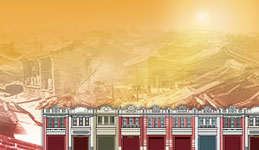          

|
|
¡@

|
 Decline
Decline
¡@¡@
Since the Ching Dynasty, the population of Lukang may decline from time
to time (due to the
backing of the port or wars).
According to the map, yellow part means the costal line in Emperor
Chenlong. Pink is for Emperor Daoquang, whereas brown is for
Emperor Kuangshi. The backing of costal line get worse as times go by.
Yet since it was the major business port of central Taiwan and due to
the successful operations of the external port and the rivers, the
business functions of ' No sky' street area were considerably
maintained. But, as time went by, the prosperity of Lukang and ' No sky'
street area diminished. Taiwan became one of Japan¡¦s colonies due to The
China Japan War, and the advent of the Japanese troops put an end to the
golden age of ' No sky' street area. ¡@ |
|
 |
|
The backing of costal
line in different era |
¡@ |
|
 TOP
TOP |
|
 Japanese Reign
Japanese Reign
¡@¡@The
immigrants from the southeastern coast of the mainland since the Dutch
and Spanish Colonial Period were attracted by the prosperous business
activities of Lukang. It was these immigrants that made possible the
growth and prosperity of ' No sky' street area and even made it the very
place that the cross-strait business took place. It follows that during
the golden age of ' No sky' street area, the agricultural products from
central Taiwan and all kinds of merchandise from the mainland would turn
this street into a comprehensive and complete shopping paradise. The
population of Lukang at that time ranged from 40 to 60,000.
But these so-called ¡§new immigrants¡¨ planned to stay in Lukang merely
for the sake of business instead of settling down in Lukang. After Japan
took over Taiwan, in a bid to enhance its business operations in Taiwan,
it announced some
colonial policy that did not
disguise the attempt to separate Taiwan from the mainland. Because of
that policy, those immigrants returned to their hometowns, which in turn
led to the sluggish economics in Lukang. From then on, the prosperity of
' No sky' street area became a memory. ¡@ |
|
 |
|
A map of Lukang in
Japanese reign |
|
|
 TOP
TOP |
|
 The end¡@¡@
The end¡@¡@
¡@¡@According
to the study conducted by Han Bao-De, in Taisho (Japanese Emperor) the
12th, the Japanese made a rough survey about the numbers of ships going
in and out of Lukang (Table 1), which shows that the numbers were stable
during the Ching Dynasty, even if they were on the wane (during the
reign of Hsein Feng). On the other hand, during the reign of Emperor
Meiji, the numbers went down from 2,000 in 1896A.D. to 392 in 1899 A.D.. It was obvious that the port could no longer function,
so ' No sky' street area was eventually
demolished.
¡@ |
|
Table 1: Numbers of Ships Going in and out of Lukang in Different
Periods of Time
|
Years |
Outport |
Import |
Total |
Age |
|
1785 A.D. |
18,000 |
18,000 |
36,000 |
Golden years |
|
1851 A.D. |
3,500 |
3,500 |
7,000 |
Decline |
|
1896 A.D. |
1,038 |
1,051 |
2,089 |
Around the end |
|
1897 A.D. |
501 |
515 |
1,016 |
Around the end |
|
1898A.D. |
420 |
438 |
858 |
Around the end |
|
1899A.D. |
195 |
197 |
392 |
Around the end |
(From the book written by Han Bao-De)
¡@ |
|
 |
 |
|
Japanese in front of
the destruction |
The street after
destruction |
¡mNext
Street¡K¡n |
|
¡@ |



